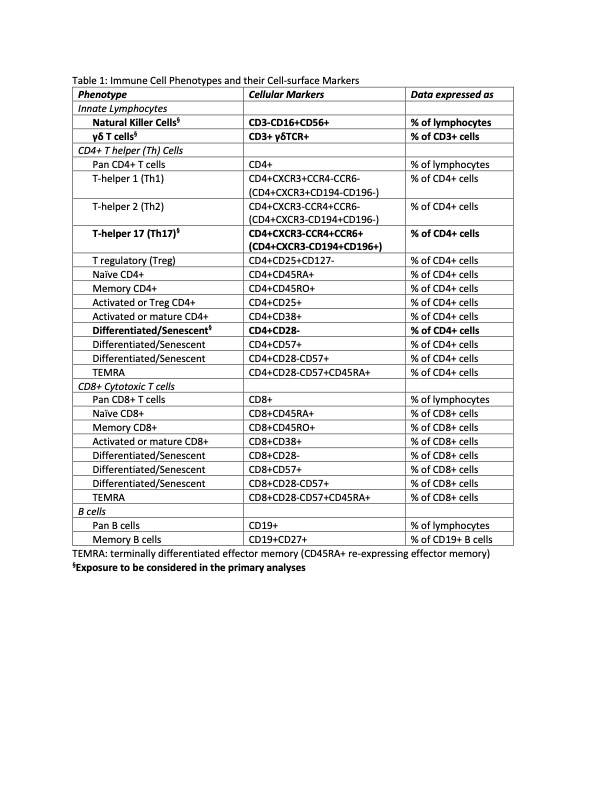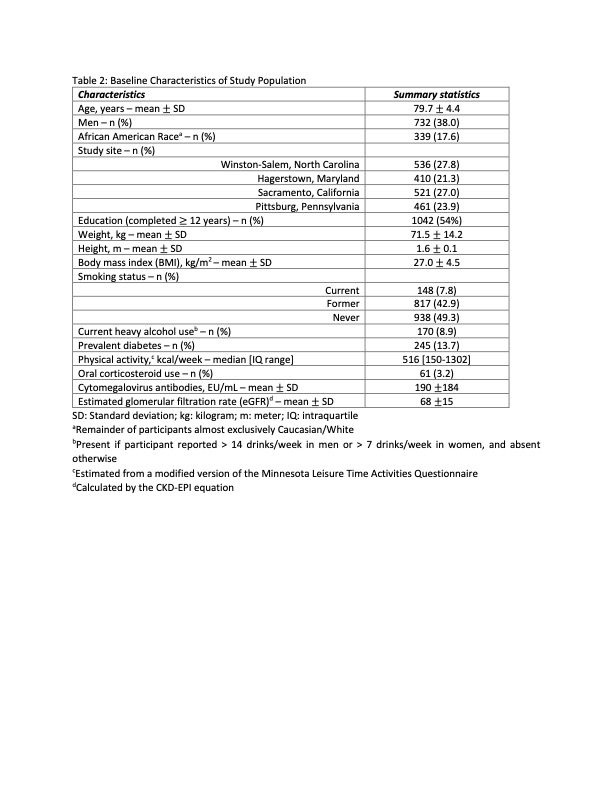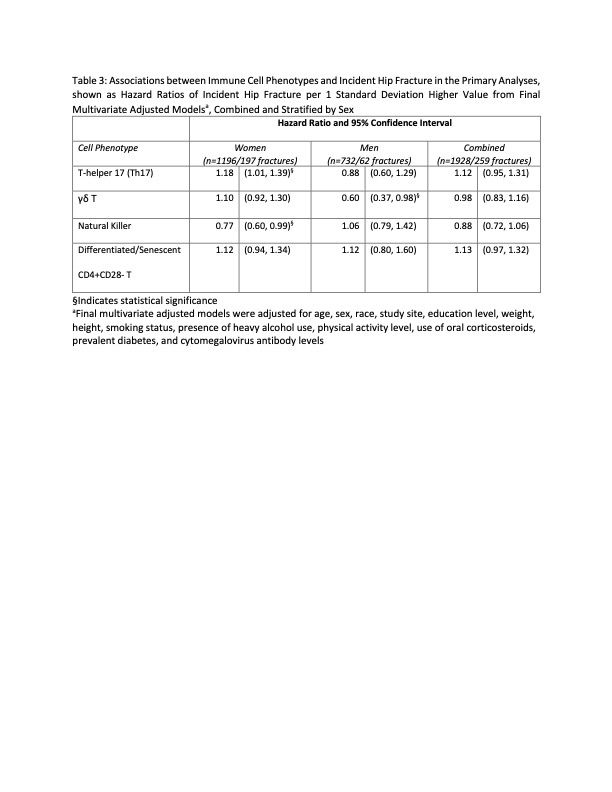Back
Poster Session C
Metabolic bone disease
Session: (1304–1331) Osteoporosis and Metabolic Bone Disease – Basic and Clinical Science Poster
1327: Immune Cell Subsets and Risk of Incident Hip Fracture in Older Adults: The Cardiovascular Health Study
Sunday, November 13, 2022
1:00 PM – 3:00 PM Eastern Time
Location: Virtual Poster Hall
- RE
Rachel Elam, MD, MS
Augusta University
Evans, GA, United States
Abstract Poster Presenter(s)
Rachel Elam1, Petra Buzkova2, Joseph Delaney3, Howard Fink4, Joshua Barzilay5, Laura Carbone1, Rick Saha1, John Robbins6, Kenneth Mukamal7, Rodrigo Valderrabano8, Bruce Psaty2, Russell Tracy9, Nels Olson9, Sally Huber10, Margaret Doyle9, Alan Landay11 and Jane Cauley12, 1Augusta University, Augusta, GA, 2University of Washington, Seattle, WA, 3University of Manitoba, Winnipeg, MB, Canada, 4University of Minnesota, Minneapolis, MN, 5Kaiser Permanente, Atlanta, GA, 6UC Davis, Davis, CA, 7Beth Israel Deaconess Medical Center, Boston, MA, 8Brigham and Women's Hospital, Boston, MA, 9University of Vermont, Burlington, VT, 10University of Vermont, Burlingon, VT, 11Rush University Medical Center, Chicago, IL, 12University of Pittsburgh, PIttsburgh, PA
Background/Purpose: Cell-mediated immunity may play a role in osteoporosis development. Fracture is the major consequence of osteoporosis. Thus, cell-mediated immunity may impact fracture risk. We evaluated whether innate and adaptive immune cell subsets in peripheral blood are risk factors for hip fracture.
Methods: The Cardiovascular Health Study (CHS) is a large U.S. cohort of community-dwelling, older (age ≥ 65 years) men and women. We included all CHS participants with at least one innate or adaptive immune cell phenotype measured by flow cytometry from cryopreserved cells collected in 1998-1999. Incident hip fractures were identified by participant report every six months following exposure measurement and confirmed by hospital medical record review. Participants were followed until first hip fracture event, death, loss to follow-up, or June 30, 2015, whichever occurred first. Cox hazard models with adjustment for fracture risk factors were used to evaluate associations of immune cell phenotypes with incident hip fracture in sex-stratified and combined analyses. T-helper 17 (Th17), γδ T, natural killer (NK) and differentiated/senescent CD4+CD28- T cell subsets were specified as subsets of interest for the primary analyses. In secondary analyses, 21 additional cell phenotypes were investigated (Table 1). A significance level of α=0.05 was used in primary and secondary analyses, with correction for multiple testing using the false discovery rate approach for the 21 immune subsets in the secondary analyses.
Results: A total of 259 incident hip fractures (n=197 in women; n=62 in men) occurred among 1928 persons over a median 9.7 years of follow-up. Baseline characteristics of the study population are described (Table 2). There were no statistically significant associations of the Th17, γδ T, NK or differentiated/senescent CD4+CD28- T cell subsets or other immune cell phenotypes with incident hip fracture in analyses combining men and women after multivariate adjustment. In women, a higher proportion of Th17 cells was associated with higher hip fracture risk (hazard ratio (HR) [95% confidence interval (CI)] of 1.18 [1.01, 1.39] per 1 standard deviation higher value) and a higher proportion of NK cells was associated with lower hip fracture risk (HR [95% CI] of 0.77 [0.60, 0.99]). In men, a higher proportion of γδ T cells was associated with lower hip fracture risk (HR [95% CI] of 0.60 [0.37, 0.98]) (Table 3). There was a significant difference between hazard ratios of incident hip fracture for men and women for NK (p=0.02) and γδ T (p=0.01) cell subsets in formal interaction testing.
Conclusion: Our study revealed important associations of immune cell phenotypes in peripheral blood and incident hip fracture that may differ by sex. Further mechanistic studies should explore whether these potential sex differences in these associations are mediated through osteoporosis development, bone quality and strength, bone turnover, sex steroid hormones or other pathways.
 Immune Cell Phenotypes and their Cell-surface Markers
Immune Cell Phenotypes and their Cell-surface Markers
 Baseline Characteristics of Study Population
Baseline Characteristics of Study Population
 Associations between Immune Cell Phenotypes and Incident Hip Fracture in the Primary Analyses, show as Hazard Ratios of Incident Hip Fracture per 1 Standard Deviation Higher Value from Final Multivariate Adjusted Models, Combined and Stratified by Sex
Associations between Immune Cell Phenotypes and Incident Hip Fracture in the Primary Analyses, show as Hazard Ratios of Incident Hip Fracture per 1 Standard Deviation Higher Value from Final Multivariate Adjusted Models, Combined and Stratified by Sex
Disclosures: R. Elam, None; P. Buzkova, None; J. Delaney, None; H. Fink, None; J. Barzilay, None; L. Carbone, None; R. Saha, None; J. Robbins, None; K. Mukamal, None; R. Valderrabano, None; B. Psaty, None; R. Tracy, None; N. Olson, None; S. Huber, None; M. Doyle, None; A. Landay, None; J. Cauley, None.
Background/Purpose: Cell-mediated immunity may play a role in osteoporosis development. Fracture is the major consequence of osteoporosis. Thus, cell-mediated immunity may impact fracture risk. We evaluated whether innate and adaptive immune cell subsets in peripheral blood are risk factors for hip fracture.
Methods: The Cardiovascular Health Study (CHS) is a large U.S. cohort of community-dwelling, older (age ≥ 65 years) men and women. We included all CHS participants with at least one innate or adaptive immune cell phenotype measured by flow cytometry from cryopreserved cells collected in 1998-1999. Incident hip fractures were identified by participant report every six months following exposure measurement and confirmed by hospital medical record review. Participants were followed until first hip fracture event, death, loss to follow-up, or June 30, 2015, whichever occurred first. Cox hazard models with adjustment for fracture risk factors were used to evaluate associations of immune cell phenotypes with incident hip fracture in sex-stratified and combined analyses. T-helper 17 (Th17), γδ T, natural killer (NK) and differentiated/senescent CD4+CD28- T cell subsets were specified as subsets of interest for the primary analyses. In secondary analyses, 21 additional cell phenotypes were investigated (Table 1). A significance level of α=0.05 was used in primary and secondary analyses, with correction for multiple testing using the false discovery rate approach for the 21 immune subsets in the secondary analyses.
Results: A total of 259 incident hip fractures (n=197 in women; n=62 in men) occurred among 1928 persons over a median 9.7 years of follow-up. Baseline characteristics of the study population are described (Table 2). There were no statistically significant associations of the Th17, γδ T, NK or differentiated/senescent CD4+CD28- T cell subsets or other immune cell phenotypes with incident hip fracture in analyses combining men and women after multivariate adjustment. In women, a higher proportion of Th17 cells was associated with higher hip fracture risk (hazard ratio (HR) [95% confidence interval (CI)] of 1.18 [1.01, 1.39] per 1 standard deviation higher value) and a higher proportion of NK cells was associated with lower hip fracture risk (HR [95% CI] of 0.77 [0.60, 0.99]). In men, a higher proportion of γδ T cells was associated with lower hip fracture risk (HR [95% CI] of 0.60 [0.37, 0.98]) (Table 3). There was a significant difference between hazard ratios of incident hip fracture for men and women for NK (p=0.02) and γδ T (p=0.01) cell subsets in formal interaction testing.
Conclusion: Our study revealed important associations of immune cell phenotypes in peripheral blood and incident hip fracture that may differ by sex. Further mechanistic studies should explore whether these potential sex differences in these associations are mediated through osteoporosis development, bone quality and strength, bone turnover, sex steroid hormones or other pathways.
 Immune Cell Phenotypes and their Cell-surface Markers
Immune Cell Phenotypes and their Cell-surface Markers Baseline Characteristics of Study Population
Baseline Characteristics of Study Population Associations between Immune Cell Phenotypes and Incident Hip Fracture in the Primary Analyses, show as Hazard Ratios of Incident Hip Fracture per 1 Standard Deviation Higher Value from Final Multivariate Adjusted Models, Combined and Stratified by Sex
Associations between Immune Cell Phenotypes and Incident Hip Fracture in the Primary Analyses, show as Hazard Ratios of Incident Hip Fracture per 1 Standard Deviation Higher Value from Final Multivariate Adjusted Models, Combined and Stratified by SexDisclosures: R. Elam, None; P. Buzkova, None; J. Delaney, None; H. Fink, None; J. Barzilay, None; L. Carbone, None; R. Saha, None; J. Robbins, None; K. Mukamal, None; R. Valderrabano, None; B. Psaty, None; R. Tracy, None; N. Olson, None; S. Huber, None; M. Doyle, None; A. Landay, None; J. Cauley, None.

